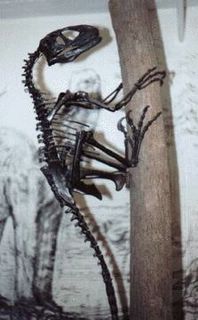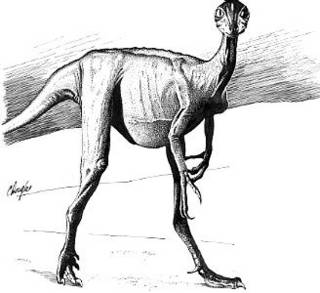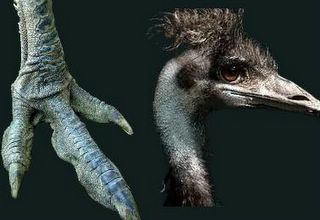“The dinosaur!, didn't they become extinct?”
Well before we start a separate debate, lets see if there is any evidence of dinosaurs that fit our model for a highly intelligent creature, and come back to their extinction later.
Well we know that many dinosaurs were bipedal so that's a start. According to biologists, one of the main reasons for the Dinosaurs supremacy was their upright bipedal movement.
So how about manipulative hands?
Well a particular dinosaur that seemed to have evolved a high degree of co-ordination in hands and arms was Deinonychus. Deinonychus had long, grasping hands with wrist joints that rotated so that the hands could turn towards each other enabling the animal to grasp its prey in both hands. Only humans, primates, and certain other mammals can do this.
It is theorised that whilst grasping its prey with its hands, it could stand on one leg and attack its prey with the claws on its other foot. This is a highly complicated dextrous ability, requiring coordination of multiple limbs. An attribute indicative of intelligent animals.
Though Deinonychus possessed opposable thumbs and swivelling wrists, they were primarily used for climbing trees and grasping prey. Its not hard to imagine this creature eventually evolving into something like a monkey or primate which is considered to be among the most intelligent of animals today.
You could however, argue that it fails to meet our definition of freeing up the hands for other tasks as they are used in vertical movement, a similar function to legs on ground.

What about Binocular Vision?
Well as this is a fundamental feature of most predators there is little doubt this can be found in the world of dinosaurs. Interestingly if you look at one of the decedents of Deinonychus you will come a across a dinosaur called the Stenonychosaurus. This animal had a set of complex and advanced features, including both manipulative fingers and binocular vision.
OK, what about brain size?
Well first of all we have to overcome the problem that cold blooded animals have relatively little to no increase in their brain size at all. However it is becoming an increasingly popular theory among Palaeontologists and Biologists alike, who believe that some dinosaurs were in fact Warm Blooded. Here is one quote of many available on this same subject -
"Once it was thought that all dinosaurs were cold-blooded - now many suggest that at least some were warm-blooded, which would help to explain why they became so plentiful and dominant for so long. If we examine today's fauna we find no large land predators that are cold-blooded, except for crocodiles that occupy only one very specific ecological niche and are basically water dwellers. The same is true of the entire Cenozoic era - virtually all large predators were warm-blooded."(More information on warm blooded Dinosaurs)
So this addresses the issue of increasing brain size. Although the body to brain ratio of the Stenonychosaurus was 1000, compared with a Humans which is about 50, we must take into account the large amount of time the Dinosaurs had to evolve and improve on this since then.
Interestingly enough, one of the fundamental differences between Deinonychus and Stenonychosaurus was that Stenonychosaurus was primarily a ground based creature not a tree dweller. It used bipedal movement to walk along the ground which thus freed up its hands. It is also among the rarest of dinosaurian fossils which is a little puzzling?. If these creatures where intelligent, and highly evolved for their time, they should be highly adaptable to change. You would expect evolution to favour the survival of such a creature, and hence provide lots more fossils or proof of their existence.

There are of course many explanations for this. Maybe its because ancestrally, like Deinonychus , they had an affinity for trees and lived in forests. Anything dying in a forest is quickly consumed by the forest fauna and not preserved or fossilised. It could simply be due to the fact it was a small creature, about 3 meters in length, and incredibly light for its size at only 45kg, with most of that being the tail. Because it was so fragile, this would also contribute to the poor preservation of its remains. There is another possible reason which we will pose later on.
One thing pointing strongly in the evidence camp for Stenonychosaurus being warm blooded, is its unusually large brain size. I say unusual because dinosaurs typically had a very small brain size compared to their large bodies. Interestingly enough, Stenonychosaurus also had the capacity for its brain size to increase during the course of its life. This is a very uncommon facet with less intelligent species, and far more befitting in our intelligent camp.
Now, as can be observe from the depiction of Stenonychosaurus above. The eyes were enormous, surpassing in size those of almost all modern land animals. This single fact alone supports our argument best. Creatures with large eyes are virtually always nocturnal or subterranean.
Now nocturnal animals are pretty much always, by way of nature, warm blooded. This enables them to control their own body temperature and be active at night when its cold. Cold blooded creatures rely heavily on heat from the sun to circulate their blood, and kick start their system so they can hunt for food etc. Cold blooded animals are virtually catatonic when it gets cold, and go into system shutdown mode at night.
Stenonychosaurus as the diagram above illustrates, also had very powerful, very long legs which would allow it to move quickly, but also if you look at the talons on its feet would allow it to dig and burrow. Almost all warm blooded nocturnal mammals have some form of underground dwelling or cave to escape the harshness of the sun during the day, so it doesn’t take much to imagine a creature like this burrowing little underground networks beneath the earth (our third reason why they are hard to find).
Virtually no exploration of what's beneath the surface of our planet has been done at all. It is estimated that most undiscovered animal species on our planet are nocturnal and live underground.
The rest of our intelligent traits, like the ability to communicate, sociability, and aggressiveness are also not difficult to imagine as characteristics of dinosaurs. It is firmly theorised that the modern birds of today are the evolutionary descendants of Dinosaurs. Birds exhibit many strong communication calls and sounds, as well as raising their young, as our criteria dictates.
Its extremely easy to see first hand the direct comparisons to birds and dinosaurs. The pictures below show the scaly foot and head of a modern day Emu.

This brings us back to the question “Didn't dinosaurs become extinct?”, and as thus could not evolve any further than they did millions of years ago. Well that's another question or point of serious contention. One of the main reasons most dinosaurs became extinct was because of their size. Something about the earths ecology changed dramatically preventing the continued support of such large organisms. A slight shift of orbit around the Sun, possibly caused by a large meteorite or other gravitational pull would explain this.
The current gravity of our planet today would never allowed such large creatures to develop in the first place. However not all dinosaurs were large, and as small mammals survived there is no reason to think that some of the more Intelligent Anthroposaurs didn't either.
Fascinatingly enough many experts are proposing that it was the advanced intelligence of Anthroposaurs that caused the mass extinction themselves, rather than any impact by a comet. Considering how short a time it has taken for man to go from stone tools to nuclear weapons, is it not possible to believe this is a pattern repeating itself.
Maybe a few highly intelligent Anthroposaurs survived the mass extinction, maybe they left the planet while it was uninhabitable, or maybe they are still here?
No comments:
Post a Comment